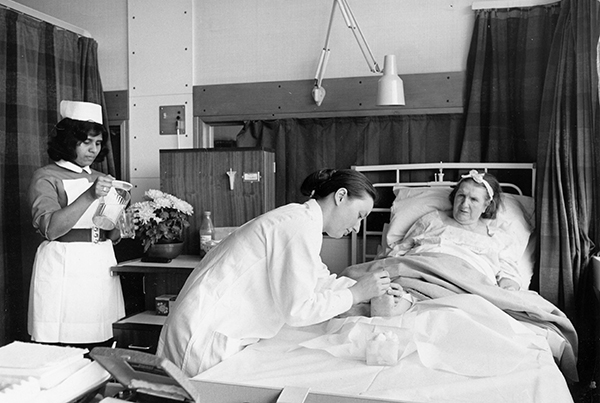How podiatry carved out a role for itself in the NHS

We take a look through the archives to see how podiatry carved out a role in the NHS
When the NHS was founded in 1948, only the most basic podiatry services were provided within hospitals. Local health authorities were granted permission to run services in the community from 1959, but these remained very limited – sometimes led by volunteers from agencies such as the Red Cross. Users were primarily elderly, prioritised due to age rather than symptoms. Little changed for more than a decade.
By the early 1970s, the Society of Chiropodists had begun to campaign for the expansion of NHS podiatry services. Th ey envisioned seeing the profession attain more, both for patients and practitioners. In a 1973 pamphlet called Chiropody – an essential service, the Society wrote: ‘Most chiropodists have been unable to use the full range of their skills because of the lack of facilities, and most patients have been unable to get more than repetitive treatment, which keeps them comfortable for only a limited period.
‘Th is is uneconomic and unsatisfactory for all concerned, including the paying authority.’
At the time, the NHS was undergoing major administrative change. Th e health service had been structured with separate systems for family practitioner, hospital and community services; now these services were being unifi ed, with the quality of care overseen by a new ombudsman.
The Society hoped that, by keeping up the pressure, they could work their five aims for the future of chiropody into a streamlined NHS. These were:
- Medical or chiropodial need, not age, should determine the patient’s right to free or subsidised treatment.
- Treatment that is progressive and aimed at a cure should be given to all priority patients who can benefi t from it. For chronic cases, the aim should be to maintain them at their optimum state of comfort and mobility.
- Facilities for ‘intensive care’ should be available.
- Facilities for appliance prescription and manufacture should be available for all chiropodists.
- Exchange of information regarding the patient should be made possible between the general medical practitioner, the hospital consultant, the hospital chiropodist and the local chiropodist. It is testament to the Society’s foresight that this vision still rings true 50 years later.
Back to the 70s
- In 1971, 992,000 people were treated by chiropody services in England and Wales.
- 950,000 of these patients were aged 65 or over.
- Just under 4.5 million treatments were performed in 1971: half of which were in clinics, one-quarter in the patient’s home, and the remainder in private practices and care homes.
- 1307 full-time-equivalent chiropodists were employed by the NHS in England and Wales in 1971.
- This was approximately one-quarter of all registered chiropodists at the time, according to HCPC data.
- By 1974, of the 176 local health authorities in England and Wales, 168 were running their own chiropody services. In the same year, 76 local health authorities were still outsourcing chiropody services to voluntary organisations such as the Red Cross.
- 105 local health authorities charged patients for chiropody services in 1974.
- The highest known charge was 50p in one London borough – though what service this bought wasn’t recorded.
(First published in The Podiatrist, July/August 2023)
